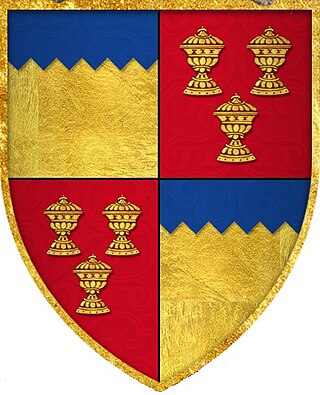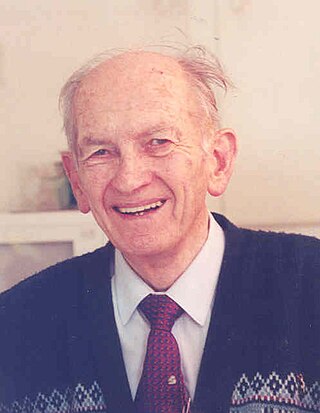
Baron is a rank of nobility or title of honour, often hereditary, in various European countries, either current or historical. The female equivalent is baroness. Typically, the title denotes an aristocrat who ranks higher than a lord or knight, but lower than a viscount or count. Often, barons hold their fief – their lands and income – directly from the monarch. Barons are less often the vassals of other nobles. In many kingdoms, they were entitled to wear a smaller form of a crown called a coronet.
The Peerage of Scotland is one of the five divisions of peerages in the United Kingdom and for those peers created by the King of Scots before 1707. Following that year's Treaty of Union, the Kingdom of Scots and the Kingdom of England were combined under the name of Great Britain, and a new Peerage of Great Britain was introduced in which subsequent titles were created.

Baron Kingsale is a title of the premier baron in the Peerage of Ireland. The feudal barony dates to at least the thirteenth century. The first peerage creation was by writ.

Lord of the manor is a title that, in Anglo-Saxon England and Norman England, referred to the landholder of a rural estate. The titles date to the English feudal system. The lord enjoyed manorial rights as well as seignory, the right to grant or draw benefit from the estate. The title continues in modern England and Wales as a legally recognised form of property that can be held independently of its historical rights. It may belong entirely to one person or be a moiety shared with other people. The title is known as Breyr in Welsh.

Fingal is a county in Ireland. It is in the province of Leinster and is part of the Eastern and Midland Region. It is one of three successor counties to County Dublin, which was disestablished for administrative purposes in 1994. Its name is derived from the medieval territory of Scandinavian foreigners that settled in the area. Fingal County Council is the local authority for the county. In 2022 the population of the county was 330,506, making it the second most populated council in Dublin and the third most populous county in the state.
False titles of nobility or royal title scams are claimed titles of social rank that have been fabricated or assumed by an individual or family without recognition by the authorities of a country in which titles of nobility exist or once existed. They have received an increasing amount of press attention, as more schemes that purport to confer or sell such honorifics are promoted on the internet. Concern about the use of titles which lack legal standing or a basis in tradition has prompted increased vigilance and denunciation, although under English common law a person may choose to be known by any name they see fit as long as it is not done to "commit fraud or evade an obligation".

In Scotland, a baron or baroness is the head of a feudal barony, also known as a prescriptive barony. This used to be attached to a particular piece of land on which was situated the caput or essence of the barony, normally a building, such as a castle or manor house. Accordingly, the owner of the piece of land containing the caput was called a baron or baroness. According to Grant, there were around 350 identifiable local baronies in Scotland by the early fifteenth century and these could mostly be mapped against local parish boundaries. The term baron was in general use from the thirteenth century to describe what would have been known in England as a knight of the shire.

Piers Butler, 8th Earl of Ormond, 1st Earl of Ossory also known as Red Piers, was from the Polestown branch of the Butler family of Ireland. In the succession crisis at the death of Thomas Butler, 7th Earl of Ormond he succeeded to the earldom as heir male, but lost the title in 1528 to Thomas Boleyn. He regained it after Boleyn's death in 1538.

A feudal baron is a vassal holding a heritable fief called a barony, comprising a specific portion of land, granted by an overlord in return for allegiance and service. Following the end of European feudalism, feudal baronies have largely been superseded by baronies held as a rank of nobility, without any attachment to a fief. However, in Scotland, the feudal dignity of baron remains in existence, and may be bought and sold independently of the land to which it was formerly attached.
The Lord High Steward of Ireland is a hereditary Great Officer of State in the United Kingdom, sometimes known as the Hereditary Great Seneschal. The Earls of Shrewsbury have held the office since the 15th century. Although the Irish Free State, later the Republic of Ireland, became independent in 1922, the title remained the same, rather than reflecting the region of Northern Ireland, which remains within the United Kingdom.

Patrick Denis O'Donnell was an Irish military historian, writer, former UN peace-keeper, and Commandant of the Irish Defence Forces.
Earl of Fingall and Baron Fingall were titles in the Peerage of Ireland. Baron Fingall was a title in the Peerage of the United Kingdom. The seat of the title-holders was, from its establishment until 1953, Killeen Castle in County Meath, Ireland, and there was an ongoing close relationship with the related Plunkett family of Dunsany, and with the Viscounts Gormanston, with whom they intermarried. Around 1426, Christopher Plunkett was created Baron Killeen: his seven sons founded five separate branches of the Plunket family, including the Plunkets of Dunsany, Rathmore and Dunsoghly. He also had a daughter Matilda, who became celebrated as "the bride of Malahide", when her first husband, Thomas Hussey, Baron Galtrim, was reputedly murdered on their wedding day.
A Lord in the Baronage of Scotland is an ancient title of nobility held in baroneum, which Latin term means that its holder, who is a feudal lord, is also always a feudal baron. The holder may or may not be a Lord of Regality, which meant that the holder was appointed by the Crown and had the power of "pit and gallows", meaning the power to authorise the death sentence.

Ballygall is a small suburban area located between Glasnevin and Finglas, on the northside of the city of Dublin, Ireland. It is also a townland divided between the civil parish of Finglas and that of Glasnevin. It was settled by Vikings in the 11th century, and later by the Cambro-Normans.
The barony of Castleknock is one of the baronies of Ireland. Originally part of the Lordship of Meath, it was then constituted as part of County Dublin. Today, it is in the modern county of Fingal, Ireland. The barony was originally also a feudal title, which became one of the subsidiary titles of the Viscounts Gormanston.
Balrothery East is one of the baronies of Ireland. Originally part of the Lordship of Meath, it was then constituted as part of County Dublin. Today, it is in the modern county of Fingal.
Balrothery West is one of the baronies of Ireland. Originally part of the Lordship of Meath, it was then constituted as part of the old county of Dublin. Today, it lies in the modern county of Fingal.

Upper Ossory was an administrative barony in the south and west of Queen's County in Ireland. In late Gaelic Ireland it was the túath of the Mac Giolla Phádraig (Fitzpatrick) family and a surviving remnant of the once larger kingdom of Ossory. The northernmost part of the Diocese of Ossory and medieval County Kilkenny, it was transferred to the newly created Queen's County, now known as County Laois, in 1600. In the 1840s its three component cantreds, Clarmallagh, Clandonagh, and Upperwoods, were promoted to barony status, thereby superseding Upper Ossory.
Nethercross is a feudal title of one of the baronies of Ireland. Originally part of the Lordship of Meath, it was then constituted as part of the County Dublin. Today, is in the modern county of Fingal.
The Lordship of Meath was an extensive seigneurial liberty in medieval Ireland that was awarded to Hugh de Lacy by King Henry II of England by the service of fifty knights and with almost royal authority. The Lordship was roughly co-extensive with the medieval kingdom of Meath. At its greatest extent, it included all of the modern counties of Fingal, Meath, Westmeath as well as parts of counties Cavan, Kildare, Longford, Louth and Offaly. The Lordship or fiefdom was imbued with privileges enjoyed in no other Irish liberty, including the four royal pleas of arson, forestalling, rape, and treasure trove.









